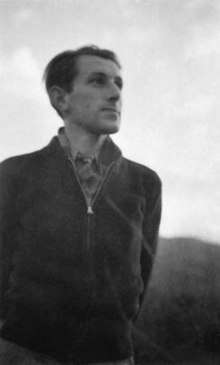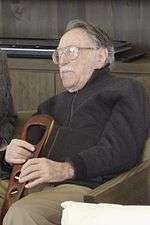Julius Shulman
Julius Shulman (October 10, 1910 – July 15, 2009) was an American architectural photographer best known for his photograph "Case Study House #22, Los Angeles, 1960. Pierre Koenig, Architect." The house is also known as the Stahl House. Shulman's photography spread California Mid-century modern around the world. Through his many books, exhibits and personal appearances his work ushered in a new appreciation for the movement beginning in the 1990s.
Julius Shulman | |
|---|---|
 Julius Shulman, Self-Portrait, c.1935 | |
| Born | October 10, 1910 Brooklyn, New York, United States |
| Died | July 15, 2009 (aged 98) Los Angeles, California, United States |
| Occupation | Architectural photographer, environmentalist |
| Years active | 1936–2009 |
| Spouse(s) | Emma (1937–1973, her death); Olga (1976–1999, her death)[1] |
| Children | 1 |
His vast library of images currently resides at the Getty Center in Los Angeles. His contemporaries include Ezra Stoller and Hedrich Blessing Photographers. In 1947, Julius Shulman asked architect Raphael Soriano to build a mid-century steel home and studio in the Hollywood Hills.[2]
Some of his architectural photographs, like the iconic shots of Frank Lloyd Wright's or Pierre Koenig's remarkable structures, have been published countless times. The brilliance of buildings like those by Charles Eames, as well as those of his close friends, Richard Neutra and Raphael Soriano, was first brought to light by Shulman's photography. The clarity of his work demanded that architectural photography had to be considered as an independent art form. Each Shulman image unites perception and understanding for the buildings and their place in the landscape. The precise compositions reveal not just the architectural ideas behind a building's surface, but also the visions and hopes of an entire age. A sense of humanity is always present in his work, even when the human figure is absent from the actual photographs.
Many of the buildings photographed by Shulman have since been demolished or re-purposed, lending to the popularity of his images.
Life and career
Julius Shulman was born in Brooklyn on October 10, 1910, and grew up on a small farm in Connecticut before moving to Los Angeles while still a boy. He briefly attended the University of California, Los Angeles and the University of California, Berkeley, and earned pocket money by selling his photographs to fellow students.[1] In 1936 he returned to Los Angeles, where he was enlisted by a friend, working as a draftsman for Neutra, to take photographs of a new, Neutra-designed Kun Residence in Hollywood with his amateur Kodak Vest Pocket camera. When Neutra saw the pictures, he asked to meet the photographer and proceeded to give him his first assignments which assisted Shulman in launching his career in architectural photography. Shulman opened a studio in Los Angeles in 1950, by that time drawing much of his work from magazines based in New York. He remained in business full-time until the late 1980s.[1] In 2000, Shulman gave up retirement to begin working with business partner Juergen Nogai.
Exhibitions
The Getty Research Institute held a 2005–2006 exhibition of Shulman's prints entitled "Julius Shulman, Modernity and the Metropolis".[3] The exhibition included sections entitled "Framing the California Lifestyle," "Promoting the Power of Modern Architecture," "The Tools of an Innovator" and "The Development of a Metropolis".[3] The exhibition traveled to the National Building Museum[4] and to the Art Institute of Chicago.[5]
.jpg)
Julius Shulman and Juergen Nogai have had exhibitions at the Design and Architecture Museum in Frankfurt, Germany, in fall 2005 as well as an exhibition at the Barnsdall Municipal Gallery in Los Angeles 2006, Craig Krull Gallery Bergamot Station, Los Angeles, October 2007, and another show in spring 2009. An exhibition of their work is also scheduled in Mannheim, Germany, in 2010.
On December 16, 2007, Shulman attended a showing of his architectural photography at the Los Angeles Public Library.[6] Organized by the Getty Research Institute, the exhibit included 150 photographs documenting architectural changes in Los Angeles over the past 80 years. This progression includes the redevelopment of Bunker Hill, the growth of Century City, the avant-garde architectural designs in Los Angeles such as Watts Towers, Grauman's Chinese Theatre and the Getty Villa, as well as the growth of Wilshire Boulevard. The exhibition features the industrial engines at the Port of Los Angeles and the Los Angeles International Airport that helped fuel the growth of Los Angeles. Also featured, diverse residential fabric from Echo Park to South Los Angeles. The exhibit spotlighted Shulman's unique role in capturing and promoting innovative, sleek case study houses as well as the contrasting tract housing developments with repeated floor plans.
In February 2008, the Palm Springs Art Museum presented "Julius Shulman: Palm Springs," guest curated by Michael Stern. Containing more than 200 objects, it is the largest Julius Shulman exhibition ever presented to date. In addition to photographs and renderings, illustrations and models of many of the buildings Shulman photographed were presented to complement his extensive documentation of a place that was so inspirational to him. Rizzoli published the accompanying catalog, "Julius Shulman: Palm Springs." Additionally, a documentary DVD was produced in conjunction with the exhibition "Julius Shulman: Desert Modern."
Selected Shulman works were included in The Annenberg Space for Photography's inaugural exhibit, Los Angeles.[7] One of his last commissioned works was of the Space, which opened in March, 2009, with Shulman in attendance.
Shulman's last exhibition was scheduled for July 4 to August 8, 2009, but his death one week into the show caused it to be extended by two weeks. Shulman's daughter Judy Shulman McKee—along with Krull, Nogai, Benedikt Taschen and Wim de Wit—spoke at the Getty Center on Sunday, September 20, 2009 during a memorial to celebrate the life of Julius Shulman.[8]
Film
Huell Howser Productions, in association with KCET/Los Angeles, featured Shulman in Julius Shulman – Palm Springs.[9]
Shulman was the subject of a 2008 documentary film, Visual Acoustics: The Modernism of Julius Shulman. The film, directed by Eric Bricker and narrated by Dustin Hoffman, explores Shulman's life and work. It discusses how Shulman's images helped to shape the careers of influential 20th-century architects, including Frank Lloyd Wright, Richard Neutra and John Lautner. The film won the 2009 Palm Springs International Film Festival Audience Award for Best Documentary Feature as well as awards at the Austin Film Festival, Newport Beach Film Festival and the Lone Star International Film Festival. The film was released theatrically by Arthouse Films across the U.S. late 2009 through early 2010.
Death and honors

In 1987, the Shulman House was designated a Cultural Heritage Monument by the city of Los Angeles.[2] Shulman himself had a Golden Palm Star on the Palm Springs Walk of Stars dedicated to him in 2006.[10] He died at his home in Los Angeles, California on July 15, 2009; he was 98 years old.[11] He was buried at Hillside Memorial Park Cemetery in Culver City, California.[12]
Bibliography
- Head, Jeffrey (Summer 2007). “Shulman face to face” (interview with Julius Shulman), CA Modern magazine, pp. 16–17
- Head, Jeffrey (Summer 2006). "A Conversation with Julius Shulman”, Case Study House #21, pp. 9–12. Chicago, IL: Richard Wright
- Leet, Stephen (2004). Richard Neutra's Miller House. New York, NY: Princeton Architectural Press. ISBN 978-1568982748. LCCN 2003-21531.OCLC 473973008
- Rosa, Joseph (2004). A Constructed View: The Architectural Photography of Julius Shulman. New York, NY: Rizzoli International. ISBN 978-0847817771.
- Shulman, Julius; Stern, Michael; Hess, Alan (2008). Julius Shulman: Palm Springs. New York, NY: Rizzoli International. p. 208. ISBN 978-0-8478-3113-5.
- Stern, Michael (February 2008). "Julius Shulman: The Man Behind the Camera", Palm Springs Life, pp. 80–91
References
- Andy Grundberg (July 17, 2009), Julius Shulman, Photographer of Modernist California Architecture, Dies at 98 New York Times.
- Wagener, Wolfgang (2002). Raphael Soriano. Phaidon Press. ISBN 978-0714840635.
- Getty Research Institute. Julius Shulman, Modernity and the Metropolis. October 11, 2005 – January 22, 2006. Retrieved August 29, 2008.
- National Building Museum. Julius Shulman: Modernity and the Metropolis. April 1, 2006 – July 30, 2006. Retrieved August 29, 2008.
- Art Institute of Chicago. Julius Shulman: Modernity and the Metropolis. Archived 2006-12-01 at the Wayback Machine September 2, 2006 – December 3, 2006. Retrieved August 29, 2008.
- Los Angeles Public Library. Julius Shulman's Los Angeles. October 6, 2007 – January 27, 2008. Retrieved August 29, 2008.
- "L8S ANG3LES". Annenberg Space for Photography. Archived from the original on 25 April 2013. Retrieved 25 April 2013.
- Hawthorne, Christopher (21 September 2009). "At the Julius Shulman Memorial". Los Angeles Times.
- Howser, Huell (October 24, 2010). "Julius Shulman – Palm Springs (21)". California's Gold. Chapman University Huell Howser Archive.
- Palm Springs Walk of Stars: By Date Dedicated
- Luther, Claudia (17 July 2009). "Julius Shulman dies at 98; celebrated photographer of modernist architecture". Los Angeles Times.
- Hillside Memorial
External links
![]()
- Union List of Artist Names, Getty Vocabularies. ULAN Full Record Display for Julius Shulman, Getty Vocabulary Program. Getty Research Institute, Los Angeles, California.
- Finding Aid for Julius Shulman Photography Archive, Getty Research Institute